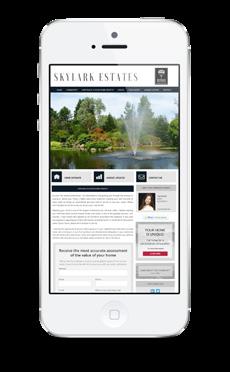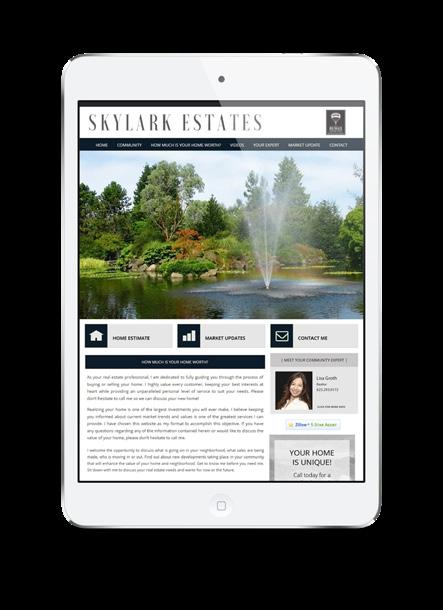
6 minute read
CHAPTER FIVE
NEIGHBORHOOD-SPECIFIC REAL ESTATE WEBSITES
We know what you’re thinking — websites are the cornerstone of any successful marketing campaign, and should be given priority every step of the way…right? In the real estate industry, this isn’t the case at all. In fact, for real estate professionals everywhere, websites should ultimately be used as validation tools. That is, websites should be used as a means of reinforcing the messaging and branding you’re already promoting via your direct mail marketing efforts. You want to create a consistent experience across the board for your audience, so always update your website and social media profiles so that they align with the image you’re curating via the property brochures, listings presentations, and real estate postcards you’re sending out.
According to the National Association of REALTORS® (NAR), only 5% of people find their real estate agent online. This means the overwhelming majority of people still select a real estate agent via some offline method. Another eye-opening NAR stat: 78% of homeowners state that they would partner with their local neighborhood expert if there was one — or, better stated, if they were clear on who that individual real estate agent was. So if we know that the majority of people select their real estate agent offline, and we know that the majority of homeowners really have no idea who the local neighborhood expert is in their community, wouldn’t it stand to reason there’s a greater opportunity to secure potential leads via direct mail efforts first, and that website development should supplement that instead? We think so too. Let’s check out the different elements of a real estate website and how you should tie everything together for a more consistent offline-online presence in your given market.
What’s the best approach with real estate websites?
At REAL Marketing, we encourage our partners to have a website that focuses on neighborhoodspecific information. Think about it. The last thing you want is for your print marketing efforts to help establish you as the neighborhood expert, only for your website to say that you service multiple neighborhoods and offer a more “general” approach than the unsuspecting homeowner may have anticipated. So, it’s a good idea to generate a neighborhood specific website for each market that you’re actively targeting. This way, your website reinforces the idea that you’re the neighborhood expert rather than works against it.
Now that we’ve established that an optimal approach potentially involves multiple neighborhoodspecific websites, you need to ensure that each one of those websites is built with capturing leads in mind. Your website is a tool, just like your postcards, property brochures, and other marketing materials. Just like those print pieces are designed with the very specific purpose of lead capture in mind, so too should your website. A real estate website is a great way to retain the leads that come through as the result of your direct mail marketing efforts, and it should be built with conversion in mind at all times.
What should I put on my real estate agent website?


Here are a few important elements to include on your real estate website to support higher clickthrough rates and customer conversions:

Be Authoritative
Prospective clients immediately need to know if you’re trustworthy and worth looking into further. Add videos, photos, and testimonial content that encapsulate the success you’ve previously had with buyers and sellers in the specific market that you’re targeting. Be clear and concise with your messaging in order to prove to prospective clients that you’re the right real estate agent for them to partner with. Additionally, share how you’ve previously had a positive impact on the lives of other people in the neighborhoods you specialize in servicing.
Improve Website Speed
Did you know the average adult’s attention span is only eight seconds in length? That’s a full second less than a goldfish! With this in mind, be sure not to clutter your website with high-quality imagery and moving animations, unless they have been optimized for high-speed page loading. If your images are not optimized, your webpages will inevitably load slower and prevent you from capturing visitors’ attention in those crucial seconds. With any website, there’s nothing worse than slow load speeds, especially given that those load speeds are potentially going to (indirectly) associate you with lower quality service overall.
From a more technical point of review, also keep in mind that Google and other search engines take page-loading speeds into account when it comes to search rankings, so if you’re following SEO best practices for better search placement and indexing on search engines, don’t forget to implement technical SEO best practices as well.
At all stages of the design process, be sure to keep user experience in mind and always attempt to create the best user experience possible. If your property brochure tells recipients to visit your website for a virtual walkthrough of the property, be sure you deliver a high-quality virtual walkthrough so that meet (but hopefully exceed) their expectations.
If Possible, Consider Implementing IDX on Your Website
Instead of your current or prospective homebuyers having to hop around from site to site to browse through local listings, Internet Data Exchange (IDX) allows users to view relevant listings without ever leaving your website. By implementing IDX, you won’t have to update the listings yourself, as they automatically update from the source. You can also customize your IDX listing to show properties you think have higher desirability for your target audience. Keeping website traffic on your website is another search metric that Google and other search engines take into account when determining search placement, and should be a consideration when implementing your SEO strategy.
Please note though that IDX integration requires a separate IDX function/plug-in, and that implementing it on your website is subject to board and broker approval first.
Be Mobile-Friendly to Aid in the Conversion Process
For optimal customer conversion, it is important that your website is designed and optimized to be mobile-friendly. As more and more people use mobile devices for much of their web browsing, having a mobile-friendly website is key to being able to accommodate the largest number of people possible.
Each Market You’re Targeting Deserves It’s Own Website
Remember, since so few people actually select a real estate agent online, the majority of people coming to your website have likely already interacted with another one of your marketing campaigns (most likely a direct mail marketing piece). When they arrive at your website, you want to make sure that they’re continuing along the exact same path they’ve already ventured down via your already familiar marketing approach.
A real estate agent that services an entire city, county, or even state is not a neighborhood expert. A neighborhood expert is someone who knows the ins and outs of a particular market, has experience partnering with clients in that market, and focuses their marketing efforts on that specific market. If you want to be the neighborhood expert, having neighborhood-specific websites for your target markets is an absolute must.
5 Trends In Building Real Estate Agent Websites
Here are some of the more popular (and effective) digital marketing approaches that successful real estate against are leveraging to help supplement their direct mail marketing campaigns:
Content Marketing
An inexpensive yet effective way for generating leads is providing value to your audience via web content. Blogging is a popular example of this, as it is a means for providing free, valuable information to your target audience. Posting blogs on your website will help build your credibility, establish an SEO presence, and give you another opportunity to establish your brand voice with your target audience within the specific market that you’re targeting.
The great thing about email is that it’s practically limitless. You can incorporate any number of different kinds of content, including graphics, photos, videos, and, of course, written content. The best part? Your email marketing efforts will find their way directly into the inboxes of past, current, and future clients. Additionally, email is a great way to promote the content on your website, including blogs, videos, livestream events, etc.
Email marketing is most effective when it’s used in tandem with a well-thought segmentation strategy. Purposeful segmentation allows you to customize and personalize your emails to specific locations, homebuyers, sellers, or any other segmented email list you choose to develop, and helps you deliver content that is both relevant and timely.
So, in the same way we recommend segmenting the specific markets you’re advertising in, we also recommend taking a more tailored approach when it comes to the email content that you choose to help reinforce your existing direct mail campaigns.
Virtual Reality
In light of a global pandemic, real estate agents have had to improvise and find ways to continue showing houses at a time when in-person contact is difficult. VR tours of homes are becoming more and more common, especially as homebuyers have become more comfortable with researching a home’s details online.
Testimonial Videos
Since in-person contact isn’t always possible, it’s important to share content that humanizes your real estate practice and depicts the real world effect of your services on homebuyers and sellers for future client buy-in. Testimonial videos are a great way to build your credibility and effectively gain your audience’s trust.








